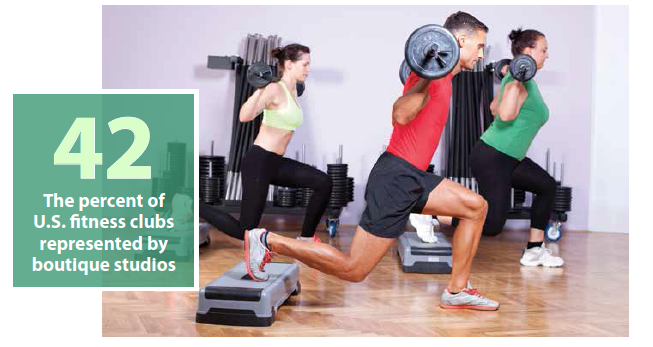
ACCORDING TO THE INTERNATIONAL HEALTH, RACQUET & SPORTSCLUB ASSOCIATION (IHRSA), almost half (42%) of U.S. fitness clubs are boutique studios—twice the number than in 2014. These studios o!er a diverse range of programming such as cycling, yoga, Pilates, personal training, CrossFit and other specialties. Boutique studios provide a social, trendy experience for gym goers to engage in a specialized workout.
Boutique gym members spend a higher percentage of their income at their gym than traditional fitness centers. According to the 2015 Health Club Consumer Report, members of clubs and studios spent roughly 0.8 percent of their income on their membership while studio members spent as much as 1.9 percent of their income.
This type of spending is sometimes called, “affordable luxury,” in which consumers make expensive purchases aligned with their lifestyles. It reveals that consumers are associating value with experience—and in this case, their health and fitness—not price. Millennials, in particular, are willing to spend more on fitness and can justify spending for studio classes over personal luxury items like clothing or handbags.
Boutiques are filling the need for those looking for highly specialized formats with a strong sense of community among members, notes Tara Sampson, general manager of VIDA Fitness & Aura Spa in Washington, D.C. Some of the ways clubs can incorporate elements of the boutique model into their strategies include:
- Offering customization and specialization for the niche audience by housing boutique studios within the fitness facility
- Integrating the fitness community into social events within the club
- Creating spaces that will be attractive and efficient for programming
- Using spatial creativity to enhance the member experience
- Devoting as much space as possible to programming while meeting support and operational needs The move to boutiques does not necessarily mean traditional fitness centers are losing members—many boutique gym members still hold traditional memberships. Clubs should use this interest to develop programming to meet this need.
SOURCE: IHRSA’S GUIDE TO THE BOUTIQUE STUDIO PHENOMENON, SPRING 2016.


